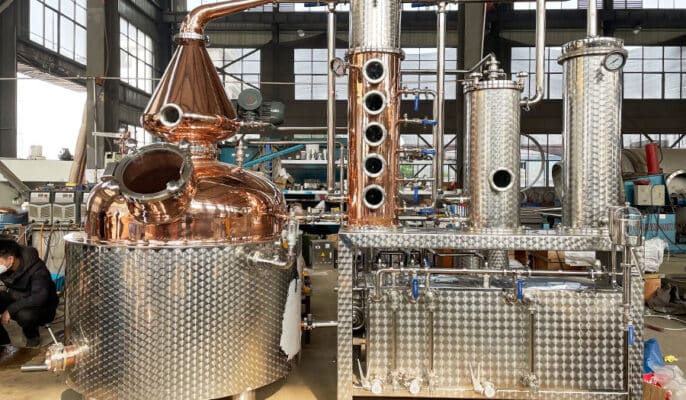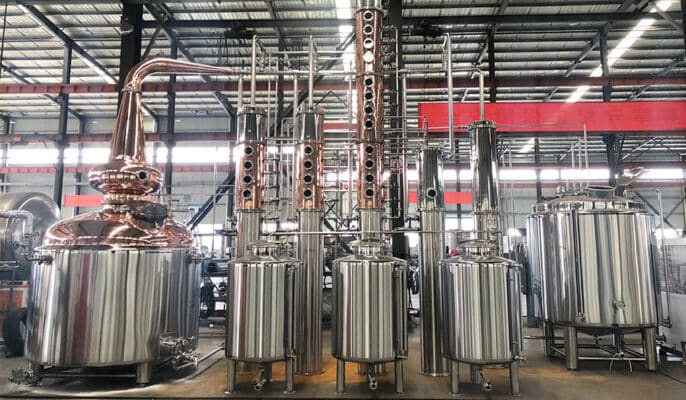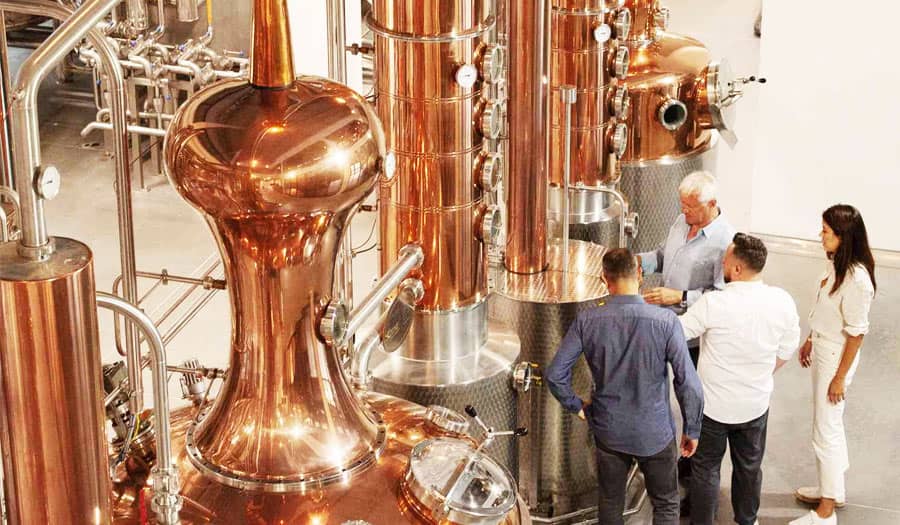The core step of making brandy is distillation, and this process is crucial to the selection of distillation equipment. There are two main types of distillation equipment: boiler distiller and continuous distiller. A boiler distiller, or batch distiller, is suitable for small-batch production and can provide more refined flavor control. Continuous distillers are suitable for large-scale production and have higher efficiency and production capacity. Choosing the right distillation equipment not only affects the flavor and quality of the wine but also determines the efficiency and economy of production.
Understanding the Brandy Distillation Process
Before we go into the detailed equipment discussion, we first need to understand the brandy production process. Brandy is an alcoholic beverage distilled from fruit wine or wine. Its production process includes four main stages: fermentation, distillation, aging, and bottling. The brandy distillation process is a key step in extracting alcohol from the fermented liquid. First, the fermented liquid is heated to the boiling point of its alcohol, and the alcohol vapor rises. Then, these vapors are cooled and converted into liquids through a condenser. Finally, separation is performed through a fractionating tower to accurately extract different levels of alcohol components. This process not only increases the alcohol concentration but also extracts rich flavor components to ensure the flavor and quality of the final brandy.

Types of Brandy Distillation Equipment
There are two main types of equipment commonly used for the distillation of brandy: boiler distiller and continuous distiller. Each piece of equipment has its own unique working principle and application characteristics.
Boiler distiller
The boiler distiller, also known as a batch distiller, is the most traditional equipment in brandy production. The working principle of this equipment is based on heating the liquid evaporating it, and then converting the vapor into liquid through condensation. Boiler distiller usually includes the following main components:
- Boiler: The boiler is the heating part of the distiller, usually made of copper or stainless steel. Its function is to heat the fermentation liquid to boiling point and evaporate the alcohol.
- Steam pipe: The alcohol vapor evaporated from the boiler is introduced into the condenser.
- Condenser: The condenser is used to cool the vapor and convert it into liquid. Traditionally, the condenser is often made of copper because copper has good thermal conductivity and chemical stability to alcohol.
- Fracturing tower: The fractionating tower is used to separate different alcohol components. Through fine control, different alcohol layers can be separated, thereby improving the flavor and purity of brandy.
The advantage of a boiler still is that it can finely control each batch of liquor, making it suitable for producing high-quality brandy. However, this equipment has low production efficiency and requires more manual intervention.
Continuous still
The continuous still, also known as the tower still, is a type of equipment suitable for large-scale production. Unlike the boiler still, the continuous still can distill in a continuous process without the need to reload the raw materials each time. Its main components include:
- Distillation tower: The distillation tower is the core part of the continuous still. It consists of multiple fractionation layers, each of which can perform independent fractionation operations. The design of the distillation tower allows alcohol and other components to be separated at different temperatures and pressures.
- Heater: The heater is used to maintain the high temperature of the distillation tower to ensure that the alcohol can continue to evaporate.
- Condensation system: The condensation system cools the vapor to form liquid alcohol. Compared with the boiler still, the condensation system design of the continuous still is more complex and can handle large-scale production.
- Reflux system: The reflux system is used to send the incompletely fractionated liquid back to the distillation tower, thereby improving the distillation efficiency.
The advantages of continuous distiller are its high efficiency and production capacity, which is suitable for large-scale production. However, due to its complex equipment, it is difficult to operate and maintain.
Principle of Brandy Distillation Equipment
- Heating: Heating is the first step in the distillation process. In a boiler distiller, the heater heats the fermentation liquid to boiling point to evaporate the alcohol. In a continuous distiller, the heater is responsible for maintaining the high temperature of the distillation tower so that the alcohol can continue to evaporate.
- Steam transmission: The evaporated alcohol vapor is transmitted to the condenser through a pipe. In a boiler distiller, this process is relatively simple. In a continuous distiller, the steam transmission system needs to handle a large amount of steam flow and ensure its uniform distribution.
- Condensation: Condensation is a key step in the distillation process. The condenser cools the steam into liquid, usually using a water-cooling system or an air-cooling system. The design of the condenser must be able to efficiently convert steam into liquid to ensure the recovery rate of alcohol.
- Fractionation: In a boiler distiller, the fractionation tower is used to separate different components in the alcohol. By adjusting the temperature and pressure, different alcohol layers can be separated to control the flavor of the brandy. In a continuous distiller, multiple fractionation layers in the distillation tower enable more refined separation operations.

How to choose brandy distillation equipment?
생산 규모
A boiler distiller is suitable for manual operation and small-batch production and can provide more refined flavor control. It allows winemakers to adjust according to the needs of each batch, but the production efficiency is low. A continuous distiller is suitable for high-volume demand. Its design can handle a large amount of raw materials in a continuous process, with high production efficiency, but the equipment investment and maintenance costs are high.
Quality requirements
Boiler distiller can provide fine flavor adjustment and control, suitable for high-end brandy production. Its fractionation tower design allows fine separation of alcohol components, which helps to enhance the complexity and richness of the wine. Continuous distiller can handle a large amount of raw materials and maintain stable production, but may not be as flexible as boiler distiller in flavor adjustment.
Operational complexity
Boiler distiller is usually easy to operate and suitable for small wineries or manual production. Its process is easy to control and adjust but requires more manual intervention. Continuous distiller is mostly equipped with an advanced automatic control system, which can monitor and adjust parameters such as temperature and pressure in real-time, reducing the complexity of manual operation, but requires professional technicians to operate and maintain.
Maintenance cost
The maintenance of a boiler-type distiller is relatively simple, but the performance of the boiler and condensing system needs to be checked regularly. The maintenance cost of a continuous distiller is higher because of its complex structure, involving multiple components and systems, and requires a professional maintenance team. When selecting equipment, long-term operating costs should also be considered, including factors such as energy consumption, maintenance, and equipment depreciation. Although the initial investment of continuous distiller is high, in the long run, higher production efficiency may bring better economic benefits.
Application of current technology in brandy 증류 장비
- Automatic control system: Modern distillation equipment is usually equipped with an automated control system that can monitor and adjust temperature, pressure, and flow in real-time. This system not only improves production efficiency but also ensures the stability and consistency of the wine.
- High-efficiency heat exchange technology: High-efficiency heat exchange technology has been widely used in modern distillation equipment. This technology can improve the utilization rate of thermal energy, reduce energy consumption, and improve distillation efficiency.
- Precision fractionation technology: Modern distillation equipment uses precision fractionation technology to separate different components in alcohol more finely. The application of this technology makes the flavor of brandy richer and more diverse.
자주 묻는 질문
What types of distillation equipment are needed to make brandy?
There are two main types of distillation equipment required to make brandy: boiler stills and continuous stills. Boiler stills are suitable for small batches and can provide fine flavor control. Continuous stills are suitable for large-scale production, with high efficiency and production capacity, and can continuously process large amounts of raw materials.
How does a boiler still work?
A boiler still heats the fermentation liquid to evaporate the alcohol, and the vapor is cooled and converted into liquid through a condenser. It usually includes a boiler (heating part), steam pipes, condensers, and fractionation towers (used to separate the different components of alcohol). This equipment is suitable for fine control of each batch of wine and is suitable for small-scale production.
How does a continuous still work?
A continuous still processes the fermentation liquid in a continuous process through a distillation tower. The heater maintains a high temperature in the tower, causing the alcohol to evaporate and separate through multiple fractionation layers. The vapor is cooled into a liquid through a condensation system. This equipment is suitable for large-scale production, with high efficiency and high production capacity.
What are the main differences between a boiler still and a continuous still?
- Boiler distiller: suitable for small batch production, can provide fine flavor control. Easy to operate, but low production efficiency.
- Continuous distiller: suitable for large-scale production, with high production efficiency and capacity, suitable for processing large amounts of raw materials. The equipment is complex and the maintenance cost is high.




